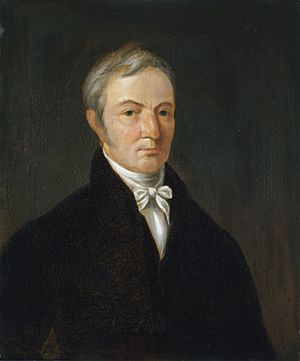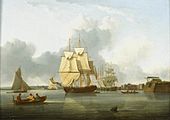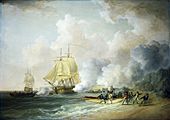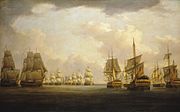William Anderson (artist) facts for kids
William Anderson (born 1757, died 1837) was a talented artist from Scotland. He was famous for painting pictures of ships and scenes about his country. People really liked his paintings because they showed ships sailing with amazing detail and accuracy. He showed his artwork every year in London from 1787 to 1811, and then sometimes until 1834. William Anderson also inspired other artists, especially John Ward and other painters from the Hull area.
William Anderson's Life Story
We don't know much about William Anderson's early life. But we do know he first trained to be a shipwright, which is someone who builds and repairs ships. When he was about 30, he moved to London to become a painter of sea scenes. His training as a shipbuilder helped him a lot. It gave him real knowledge about ships, which made his paintings very accurate.
People admired his work for its "accuracy and refinement of detail." They also loved his bright, clear colors. He used both oil paints and watercolors in his art.
Anderson's painting style was inspired by famous Dutch sea painters from the 1600s. He first showed his art at the Royal Academy in 1787. He also exhibited at the Royal Institution in 1810. He continued to show his paintings every year until 1811. After that, he exhibited his work on and off until 1834.
His best paintings were made between 1790 and 1810. This was during the French Revolutionary and Napoleonic Wars. During these wars, there was a high demand for paintings of naval battles and ships. Anderson didn't just paint sea scenes. In 1822, he showed a painting about the Battle of Waterloo. Like other artists of his time, Anderson often based his paintings of sea events on sketches made by people who were actually there. Wealthy people who became successful during the wars often bought his paintings.
Anderson traveled north for some painting jobs. This is where he met painters from the Hull area. He especially influenced a young artist named John Ward (1798–1849). Ward even copied some of Anderson's paintings. Anderson was also friends with, and possibly worked with, the painter Julius Caesar Ibbetson (1759–1817). His trips to the North influenced his art, leading him to paint scenes of Berwick-on-Tweed and Tynemouth. His very last painting shown at the Royal Academy was Lord Howe's fleet at Spithead in 1834. This was one of 45 paintings he showed there. William Anderson passed away in London on May 27, 1837.
What Did William Anderson Paint?
Most of Anderson's paintings were small. They often showed ships on rivers. Some of the works he showed at exhibitions include A View of Berwick-on-Tweed and A View of Tynemouth.
His paintings about historical events include:
- The Battle of Waterloo
- The Capture of Fort Louis, Martinique, 1794 (This painting shows Commander Robert Faulknor attacking Fort Saint Louis in Martinique with his ship, HMS Zebra.)
- The Battle of Cape Finisterre
- The First Battle of Groix
- The Battle of the Nile
Other paintings he created include Shipping on the Thames at Deptford and View at the Mouth of the Thames. He also made drawings, possibly of sea topics, for the pictures in Rees's Cyclopædia.
- Selected works
William Anderson's Family
William Anderson and his wife Sarah had two sons, named William and George. Anderson's son, William Guido Anderson, served in the Royal Navy. Sadly, he was badly wounded and died at the Battle of Copenhagen in 1801. He was a midshipman (a junior officer) on the ship HMS HMS Bellona. His other son, George Anderson, also became a painter.





